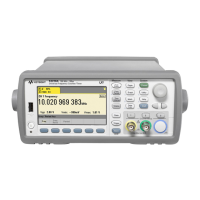You can then query the count value by sending:
TRIG:COUN?
You can also query the minimum or maximum count allowed as follows:
TRIG:COUN? MIN
TRIG:COUN? MAX
SCPI Command Terminators
A command string sent to the instrument must terminate with a <new line> (<NL>) character. The IEEE-
488 EOI (End-Or-Identify) message is interpreted as a <NL> character and can be used to terminate a com-
mand string in place of a <NL> character. A <carriage return> followed by a <NL> is also accepted. Com-
mand string termination will always reset the current SCPI command path to the root level.
For every SCPI message that includes a query and is sent to the instrument, the instrument
terminates the returned response with a <NL> or line-feed character (EOI). For example, if R?
is sent, the response is terminated with a <NL> after the block of data that is returned. If a
SCPI message includes multiple queries separated by semicolons (for example
"SYST:ERR?;R?"), the returned response is again terminated by a <NL> after the response to
the last query. In either case, the program must read this <NL> in the response before another
command is sent to the instrument, or an error will occur.
IEEE-488.2 Common Commands
The IEEE-488.2 standard defines a set of common commands that perform functions such as reset, self-
test, and status operations. Common commands always begin with an asterisk ( * ), are three characters in
length, and may include one or more parameters. Thecommand keyword is separated from the first para-
meter by a blankspace. Use a semicolon ( ; ) to separate multiple commands as shown below:
*RST; *CLS; *ESE 32; *OPC?
SCPI Parameter Types
The SCPI language defines several data formats to be used in program messages and response messages.
Numeric Parameters
Commands that require numeric parameters will accept all commonly used decimal representations of
numbers including optional signs, decimal points, and scientific notation. Special values for numeric para-
meters such as MINimum, MAXimum, and DEFault are also accepted. You can also send engineering unit
suffixes with numeric parameters (e.g., M, k, m, or u). If a command accepts only certain specific values,
the instrument will automatically round the input numeric parameters to the accepted values. The fol-
lowing command requires a numeric parameter for the count value:
SAMPle:COUNt {<count> | MINimum | MAXimum | DEFault}
Introduction to the SCPI Language
14 Keysight 53220A/53230A Programmer's Reference

